Welcome to FISH FOOD TIMES
Aug. 2025 issue No.260

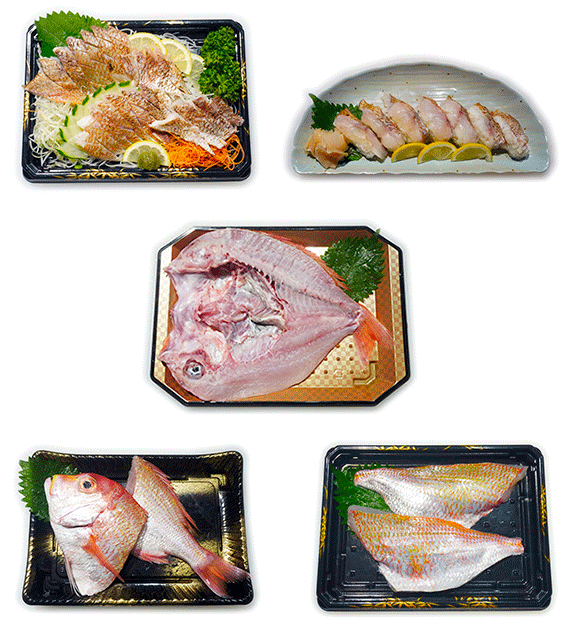
Yellowback seabream
Now in season
I were able to get hold of three yellowback seabream, which are in season at the moment, so I decided to feature this fish in this month's issue.
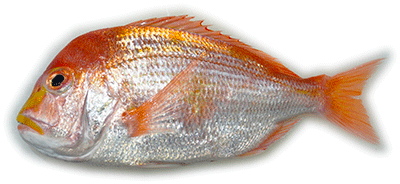
Yellowback seabream
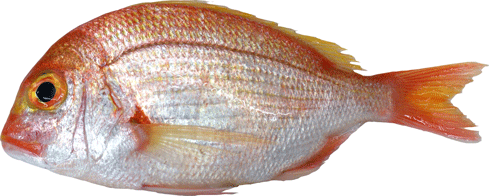
Yellowfin seabream
Yellowback seabream is one of the fish that I am familiar with because I live in Fukuoka. It was only after I began traveling to the Nansei Islands and Okinawa for my work as a fisheries consultant that I learned about the existence of the Yellowback seabream, which has a very confusing appearance and is known as the Yellowfin seabream. When I actually saw Yellowfin seabream for the first time, my impression was, "Hmm... it's Yellowback seabream, but something about it seems a little different..."
To put it simply, the difference between them is that Yellowback seabream has red fins and yellowish skin, while Yellowfin seabream has yellow fins and reddish skin. The flesh of Yellowback seabream is a little watery and soft, but the flesh of Yellowfin seabream is not as watery as Yellowback seabream, is not particularly soft, and feels firm.
The Yellowback seabream featured in the article "Celebratory Sea Bream Figure Sashimi" in FISH FOOD TIMES No. 64 (April 2009 issue) 16 years ago was actually Yellowfin seabream, which I had just learned about and tried using. The fish we will be covering in this article is the Yellowback seabream, which has a slightly watery and soft texture, and we will refer to this fish below as the Yellowback seabream.
Yellowback seabream's positioning
There is no clear distinction between Yellowback seabream and Yellowfin seabream in the fish market, and they are all collectively referred to as Renkodai. They are valued at a slightly lower level than Red seabream, and are traded at a corresponding market price.
The image below shows a large Yellowback seabream that was just landed from a fixed net at the Takahama Fisheries Cooperative in Tsushima, Nagasaki Prefecture. As you can see from this image, it has a truly magnificent, shining, and captivatingly beautiful appearance, and I feel that its appearance is in no way inferior to that of a Red seabream.
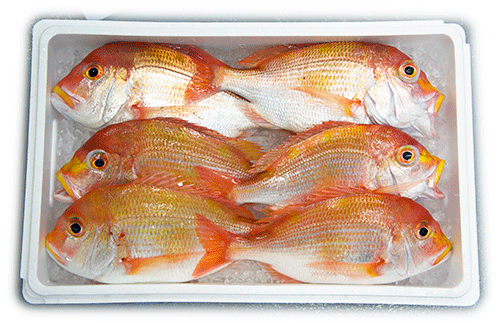
Yellowback seabream live in schools in the ocean, and it is said that the Japanese name for the fish comes from the fact that when a net is cast into the school of fish, they are all caught together. In the past, these fish were caught in large quantities in the East China Sea and other areas by bottom trawl fishing west of the bay. When I used to go to the Nagahama Fish Market in Fukuoka City every morning, I often saw Yellowback seabream sorted by size and piled up tightly in fish boxes, with their backs facing up, on the concrete of the auction area adjacent to the quay. It is relatively small compared to red seabream, and because it was caught in large quantities, it was once treated as a popular fish. For this reason, it has come to have the image of being a cheap deli fish that is not used for raw consumption such as sashimi.
Also, when trying to eat fresh Yellowback seabream caught in fixed nets like the one in the image above raw as sashimi, the watery texture of the flesh can sometimes interfere with the flavor. For this reason, in order to enjoy them, extra effort is required to control the moisture content, and this tedious work is likely one of the reasons why they are rated lower than Red seabream.
Furthermore, Yellowback seabream are mainly caught by bottom trawling or fixed nets, so only a small number are caught by fishing, making it difficult to enjoy the texture of live fish. Moreover, Yellowback seabream's naturally soft flesh may also be a reason why it is not highly rated.
To make the most of the characteristics of fish meat
As such, it is an undeniable fact that Yellowback seabream has a slightly watery and soft texture, so sales proposals must be made based on this premise.
First of all, the best way to enjoy Yellowback seabream is to grill it with salt. If I were to grill both Yellowback seabream and Red seabream with salt at the same time and ask which one I would choose, I would choose the Yellowback seabream without any hesitation.
In my experience, when you bring a grilled Yellowback seabream to the table and immediately put your chopsticks into the skin of a freshly grilled Yellowback seabream, the fluffy steam that rises from it is due to the moisture contained in the flesh of the Yellowback seabream. I feel that the texture of this moist and soft grilled Yellowback seabream has a taste that is in a class of its own compared to that of red sea bream.
With this in mind, I decided to grill one of the three Yellowback seabream with salt, but I thought that leaving it whole would be too ordinary and uninteresting, so I decided to make an opened fish product by salting it in 10% salt water.
| Yellowback seabream lightly salted opening process | |
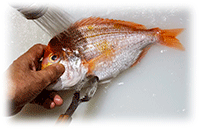 |
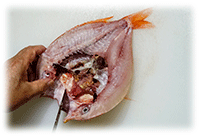 |
1,Remove the scales. |
8,Cut the head in half and open the fish. |
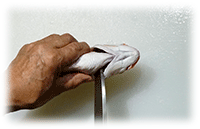 |
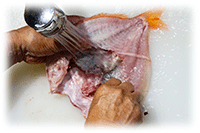 |
| 2,Cut the gill membrane and use the hara of a deba knife to press the gills outwards. | 9,Wash out the internal organs in the abdominal cavity. |
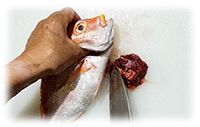 |
 |
| 3,Use the hara of a deba knife to hold the gills and separate them from the body of the fish. | 10,The abdominal cavity has been cleaned out. |
 |
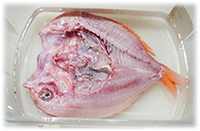 |
| 4,Starting just behind the head, cut open the upper body above the central bone. | 11,Make a 10% salt solution and soak for 30 minutes. |
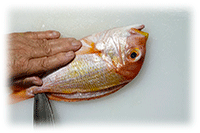 |
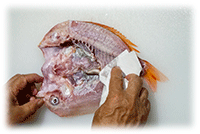 |
| 5,Cut past the backbone and up to the anal fin. | 12、Once the salt has finished soaking, wipe off any moisture on the surface. |
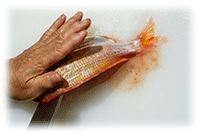 |
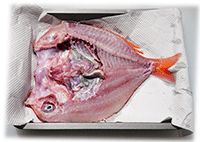 |
| 6,Turn the fish over and make an incision with the tip of a deba knife just after the head. | 13,Place kitchen paper in a container and place the fish flesh-side up. |
 |
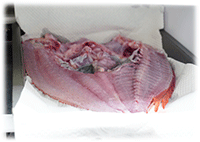 |
| 7,Lift the fish upright and press the tip of a deba knife firmly into the center of the head to split it in half. (The bones in the head of a Yellowback seabream are extremely hard, so you'll need a sharp deba knife and a lot of strength.) | 14,Leave in the refrigerator for 30 minutes. |
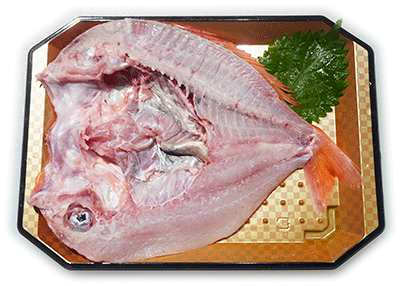 |
|
| Yellowback seabream, lightly salted and opened, with the surface lightly dried and the moisture removed. | |
I grilled this Yellowback seabream fillet with salt. However, since it was difficult to fit a 450g fish on the grill and the serving dish required a fairly large size, I decided to cut it in half lengthwise and grill it instead of leaving it open. However, when this grilled salted half is placed on a plate, if the skin side of the half with the central bone still attached is placed facing up, it will not be presented in the shape of the left head. Also, because the boneless half had no bone, the flesh curled up excessively on both sides, and both dishes ended up looking very unsightly.
The taste of the Yellowback seabream opened fish, soaked in 10% salt and lightly dried in the refrigerator, was absolutely delicious. However, as mentioned above, the appearance of the dish after grilling and serving on a plate was not very good, and I felt embarrassed to share the image here, so I decided to omit it. Considering the scene of eating opened fish at the dinner table, when selling raw opened fish, it is not necessarily better to have a larger size; each fish must weigh no more than 300g.
Fillet a fish into two pieces with the head still attached
The remaining two Yellowback seabream were to be used for sashimi, sushi, and fillets. One fish was used for sashimi, and half of each was used for sushi and fillets.
| Fillet product workflow of a fish into two pieces with the head still attached | |
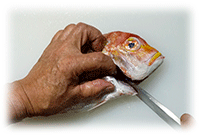 |
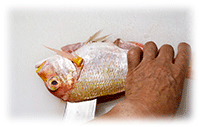 |
| 1,Make an incision in the gill membrane. | 6,Cut along the backbone from the tail fin towards the head. |
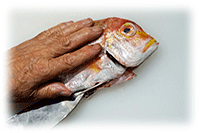 |
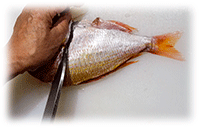 |
| 2,Cut the abdomen open vertically. | 7,Make an incision next to the collar of the fish on the lower body. |
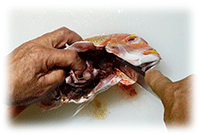 |
.gif) |
| 3,Remove the gills and internal organs. | 8,Cut off the end of the tail fin. |
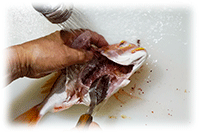 |
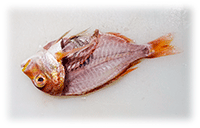 |
| 4,The inside of the abdominal cavity is washed with water and wiped dry. | 9,The lower body has been separated. |
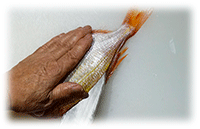 |
 |
| 5,An incision is made above the central bone from both the pelvic fin and dorsal fin edges of the lower body. | 10,Cut it in half from the upper body side. |
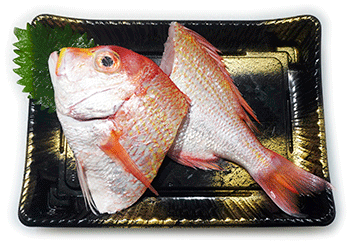 |
|
| Fillet a fish into two pieces with the head still attached | |
I made this fillet into a boiled fish dish, as shown in the image below. Even after cooking, the flesh did not harden, its soft texture made it easy to eat, and the flavor was well-absorbed, making it delicious.

Konbu-jime
Next, I decided to make sashimi out of the last Yellowback seabream. Although I was going to make it into sashimi, as you know, Yellowback seabream has a slightly watery and soft texture, so I decided that simply removing the skin and making it into sashimi would not be highly rated in terms of taste. For this reason, I decided to fillet the last fish into three pieces, and then add the remaining filleted half body to make a total of three half bodies to marinate in kelp.
When fish is cured in kelp, the moisture in the fish flesh is absorbed by the kelp, firming the flesh, and the glutamic acid in the kelp is transferred to the fish flesh, giving it a deep flavor. This is particularly true for soft, watery fish like yellowback seabream, as it is expected to firm up the flesh and enhance its umami flavor.
For the last fish, I made a regular fillet a fish into three pieces as shown below.
| Work process of Yellowback seabream fillet for sashimi, cut into three pieces | |
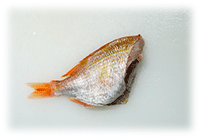 |
 |
| 1,The head has been separated using the cross-coupled technique, the internal organs removed, and the fish wiped dry. | 5,Starting from the dorsal fin on the upper body, cut over the central bone towards the backbone. |
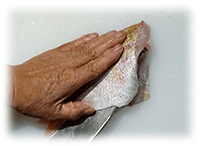 |
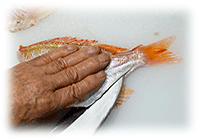 |
| 2,Starting from the anal fin on the lower body, cut over the central bone towards the backbone. | 6,Starting from the anal fin on the upper body, cut over the central bone towards the backbone. |
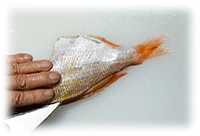 |
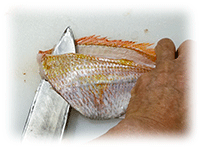 |
| 3,Starting from the dorsal fin on the lower body, cut over the central bone towards the backbone. | 7,Cut along the backbone from the tail fin towards the head. |
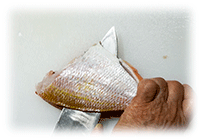 |
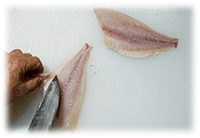 |
| 4,Cut along the backbone from the tail fin towards the head. | 8,Remove the belly bones from the upper and lower body. |
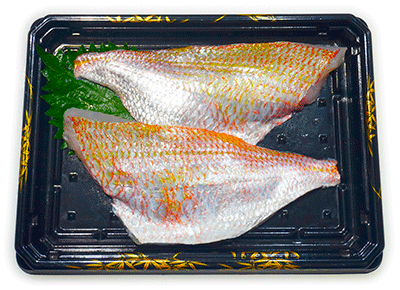 |
|
| Product of Yellowback seabream fillet a fish into three pieces | |
There were a total of three half bodies, so I soaked them all in kelp.
| Yellowback seabream's konbu-jime production process | |
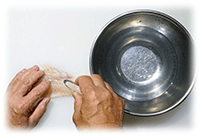 |
 |
| 1,Fillet a fish into three pieces and remove the remaining chiai bones from the half body. | 5,Wipe the surface of the kelp with paper moistened with vinegar and press it firmly onto the fish. |
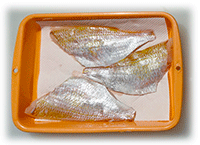 |
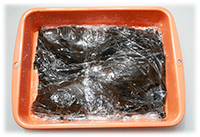 |
| 2,Line a container with water-absorbing paper and arrange three half bodies on it. | 6,The fish meat that had been soaked in kelp was wrapped in plastic wrap and left to sit in the refrigerator overnight. |
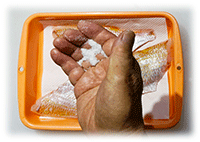 |
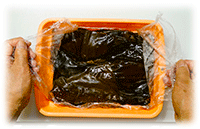 |
3,Lightly sprinkle salt on both sides of the half body. |
7,The next day, remove the plastic wrap and kelp from the surface. |
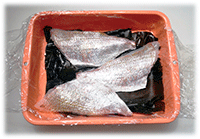 |
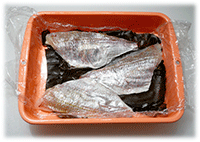 |
| 4,Wipe off any moisture that has seeped out onto the surface of the fish and arrange it on top of the kelp. | 8,The konbu-jime is now ready. |
Konbu-jime sashimi and sushi
The konbu-jime of Yellowback seabream was cooked with the skin on, so I decided to sear the skin and serve it as sashimi and sushi.
| Yellowback seabream konbu-jime grilled sashimi hiratsukuri process | |
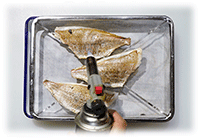 |
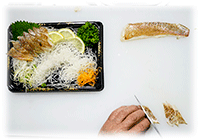 |
| 1,The skin of the konbu-jime-covered Yellowback seabream is seared over a burner. | 6,The upper belly part is made into hiratsukuri sashimi. |
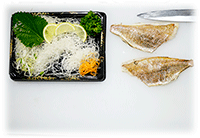 |
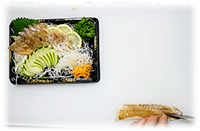 |
| 2,Prepare the upper and lower parts of one seared Yellowback seabream. | 7,Make two decorative knife lines on the back body of the lower body. |
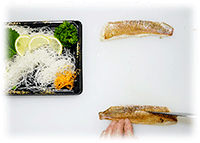 |
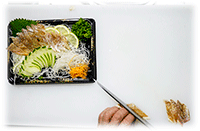 |
| 3,Make two decorative knife lines on the back body of the upper body. | 8,The lower back part is made into hiratsukuri sashimi. |
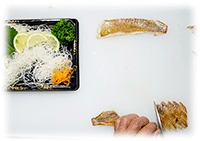 |
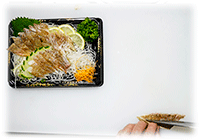 |
| 4,The upper back part is made into hiratsukuri sashimi. | 9,Make one decorative knife lines on the back body of the lower body. |
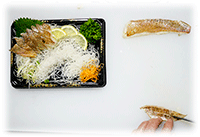 |
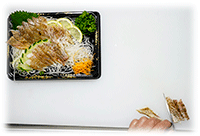 |
| 5,Make one decorative knife lines on the back body of the upper body. | 10,The lower belly part is made into hiratsukuri sashimi. |
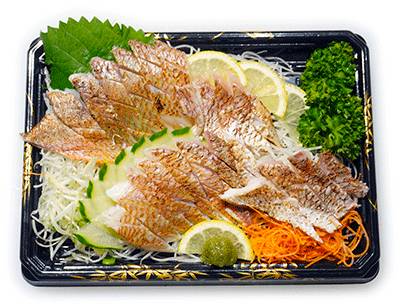 |
|
| Yellowback seabream konbu-jime grilled sashimi hiratsukuri | |
By making Yellowback seabream into konbu-jime, the konbu absorbed the moisture to a moderate extent, firming the flesh and giving it a chewy texture. In addition, searing the surface of the skin enhances the flavor, making it very tasty.
The last dish is seared Yellowback seabream konbu-jime nigiri sushi. I'd like to state in advance that I'm not a sushi chef, so I'm not good at sushi. In other words, since it's my own style, I don't think it will be of any use as a reference for sushi knowledge, but I would like to show you the fact that this is how I did it with images.
What seems particularly strange in the image is that the author is wearing vinyl gloves while making nigiri sushi. However, in fishmonger sushi, vinegar water is generally not used, and all sushi production work in the seafood department is done using vinyl gloves, so the author does the same. This may be unacceptable to sushi experts, but please understand that this is the normal form of fishmonger sushi.
| Yellowback seabream konbu-jime seared nigiri sushi production process | |
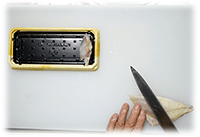 |
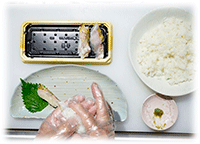 |
| 1,The lower body of a Yellowback seabream that has been treated with konbu-jime is cut into while facing left. | 6,Place the rice in your right hand on top of the sushi topping in your left hand and use your left thumb to make the wari. |
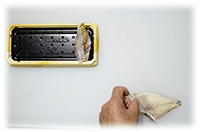 |
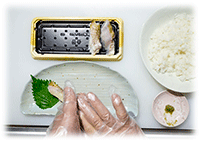 |
| 2,Leaving one piece of skin, raise the spine of the yanagiba blade, then pull it and cut. | 7,Lightly press the rice with the two fingers of your right hand and, using your left thumb, shape it into a square. |
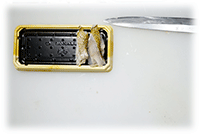 |
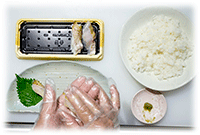 |
| 3,I finished cutting seven pieces of sushi toppings in one half of the fish. | 8,Roll the rice towards the fingertips of your left hand and turn the sushi toppings upwards. |
 |
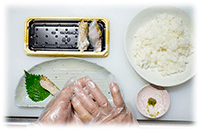 |
| 4,Hold the sushi toppings in your left hand and roll the rice with your right hand. | 9,Turn the sushi topping up and press it down again with two fingers of your right hand. |
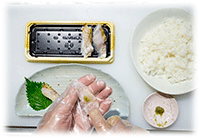 |
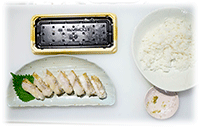 |
| 5,Put wasabi on the pad of your right index finger and place it on the sushi topping in your left hand. | 10,I finished making seven pieces of nigiri sushi. |
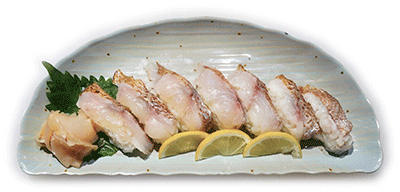 |
|
| Yellowback seabream konbu-jime seared nigiri sushi | |
The right amount of salt is key
The Yellowback seabream nigiri sushi with seared konbu-jime was delicious, as was the sashimi. When I tried cooking three Yellowback seabream by grilling them with salt, simmering them, making sashimi, and nigiri sushi, I realized that because of the unique texture of the flesh, the taste can be influenced by just the use of salt. In Japanese, the skillful use of salt in this type of cuisine is expressed as "ii anbai," and I feel that "ii anbai" is particularly important in Yellowback seabream cuisine.
The Japanese word "anbai" apparently refers to the combination of salt and plum vinegar used to season food. In the past, when vinegar was not available, people used salt and plum vinegar to adjust the flavor, and the well-balanced state was expressed as "ii anbai." Nowadays, this expression "ii anbai" is used to describe a variety of situations, not just cooking, but also the condition, amount, and health of the food.
This year, for the first time in my life, I happened to pick plums from my garden and make pickled plums. In this way, I learned how plum vinegar is made. When making umeboshi, I personally experienced that the amount of salt used can make a big difference in the way the ume vinegar comes out. Of course, I also confirmed with my own tongue that the taste changes when the amount of salt is changed.
Yellowback seabream is seen as inferior to Red seabream and is traded at a price that corresponds to that, but it can be made into a delicious dish with just the right amount of salt, so I think that when selling it, cooking suggestions should take this into account. Similarly, fish such as barracuda, Japanese bream, and tilefish, which have a lot of moisture and soft flesh, are similar to yellowback seabream and salting is thought to be the key to cooking them, but readers may know of other similar fish that I am not aware of.
I would like to see various fish become "ii anbai".
An opinion and the communication are to iinfo@fish food times
Date of updating 1 Aug. 2025
